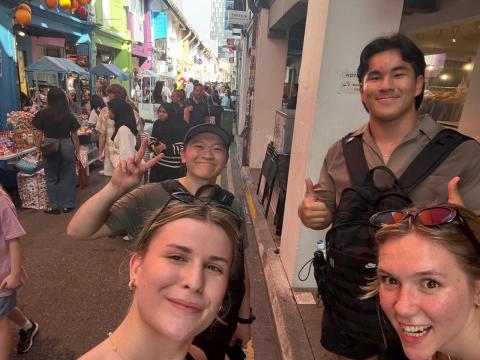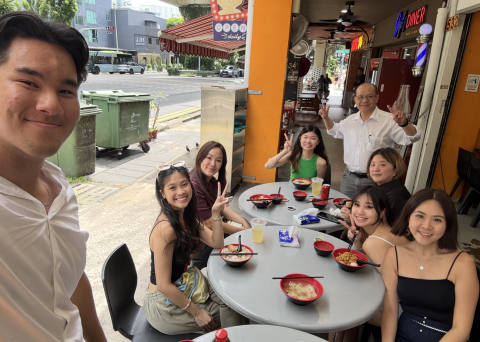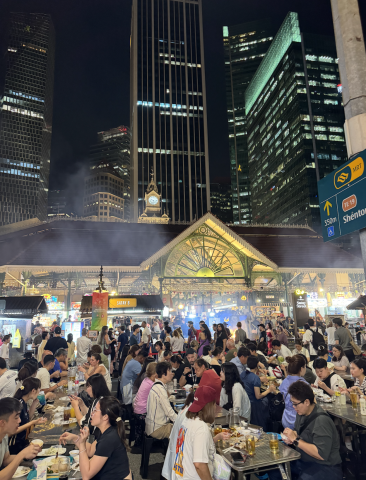Hi everyone! My name is Logan Adams, and I’m Taiwanese, Chinese, Japanese, and American. My mom is half Taiwanese and half Chinese, and my dad is half Japanese and half American. Having a mix of identities like this makes me especially excited to be in Singapore for the summer - there’s probably no better place for someone with a diverse background to feel connected to so many different cultures at once.

I was selected to participate in this program as the one UO student placed in my host company and sent to Singapore fully funded by scholarships and company support. I couldn’t have asked for a better fit. Singapore is an international business hub and a crossroads of cultures, which aligns perfectly with my professional goals and my own cultural identity. The chance to live and work here while building cross-cultural business experience felt like a once-in-a-lifetime opportunity.
Leading up to the program, I spent time thinking about how my ethnicities would show up in daily life here. I figured I’d use Chinese in conversations with locals who weren’t fluent in English, and vice versa when interacting with international coworkers or tourists. I expected that I’d blend in visually due to my Taiwanese and East Asian appearance, which has turned out to be pretty true. My past experience living in Japan also helped me feel more comfortable with the local food scene, as many dishes or flavors feel familiar.
Arrival week was a whirlwind. I’m staying in an area surrounded by Little India, Chinatown, the Sultan Mosque, and the central financial district - which makes for an incredibly vibrant but overwhelming neighborhood to first navigate. With so much cultural variety and people flowing through the streets at all times, getting my bearings was a challenge. Starting the program also meant I had to quickly learn the transit system, figure out my office location, and adjust to the intense heat and humidity that Singapore is known for.

My first impression of Singapore is that it’s a really unique cultural blend. It doesn’t feel fully Western, but it also doesn’t feel like any single Asian or Middle Eastern culture dominates. Instead, it’s a balanced fusion. I see Americans, British, East Asians, Southeast Asians, Middle Easterners - none of them shape the culture entirely, but all are clearly present in everyday life. It’s like this city is a living example of cultural coexistence, where different traditions and lifestyles sit side-by-side.
Of course, challenges came up quickly too. The biggest one has been language - specifically Singlish and the local variation of Mandarin. I came in confident, knowing both English and continental Mandarin, but the Singaporean accents and unique vocabulary made it unexpectedly hard to understand either at times. I’ve had to actively ask locals what certain words meant or how things were pronounced to connect the dots back to the way I would normally say them. It’s been humbling, but also a great learning opportunity.
The surprise, honestly, was how difficult that language gap would be. I thought my bilingual skills would let me slide right in, but I learned quickly that dialect, tone, and accent can make a big difference - even when the language is technically “the same.” Still, I’ve been working through it, and every interaction helps me grow more confident navigating Singapore’s unique style of communication.

To other students with mixed or multicultural identities like mine: prepare well. Beyond the big stuff like sightseeing and travel plans, dig into the small things - where to buy groceries, how to use public transit, which local apps are worth downloading, and how to spot which side of the road your bus is going. That kind of groundwork can really help you feel settled faster. And most importantly, don’t feel like you have to “pick a side” when it comes to your identity. Being mixed lets you connect with more people and cultures, not fewer. You can adapt, relate, and find common ground with different groups because you carry a piece of many cultures with you. Whether you're half Asian and half Western or a blend of many backgrounds, use that to your advantage. It’s not about choosing one - it’s about appreciating all of them.
Logan Adams, Diverse Duck Ambassador
